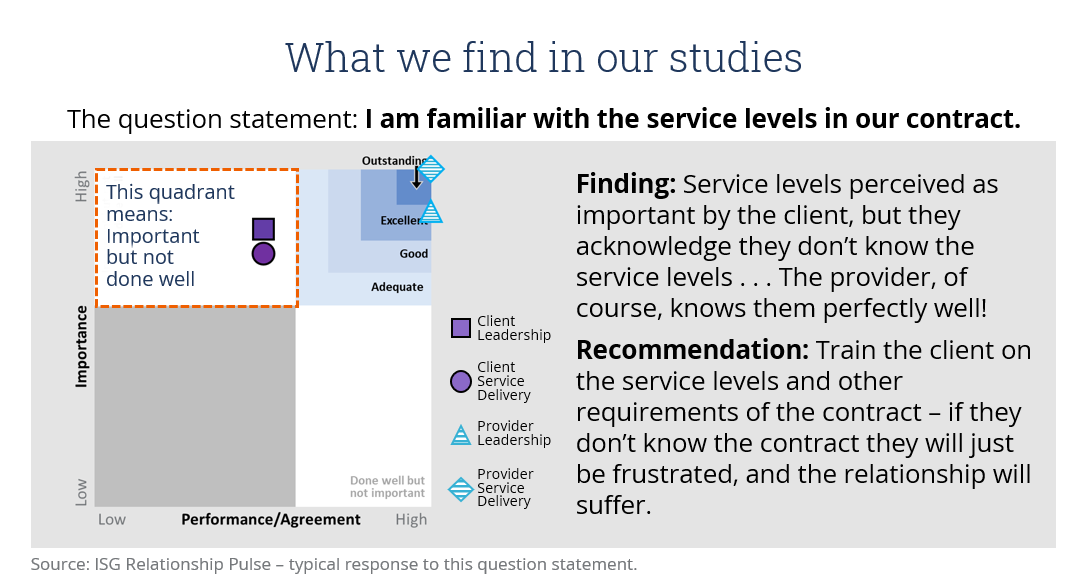I’ve often said over the years that sourcing providers know how to deliver services, but their clients do not know how to receive them. These days I would add that providers lack the institutional knowledge (and brand permission!) to help their clients learn to receive their services. Both parties to sourcing contracts tend to come at their relationship at the micro level – the client team and the provider team – each on their own island, each with preconceived ideas about its value. At the coal face of the relationship, neither party is really prepared for what is going to happen as the transition and services unfold, stakeholders get frustrated and tensions rise.
How can we make sure each party comes to the relationship with the right frame of mind?
The goal doesn’t have to be friendship, but there must be some acceptance that we are all in this together – and, to accept that, both sides need to understand the terms of reference (the contract, relationship requirements and measurement) for such a relationship. We tend to think these days that sourcing relationships are a known entity and everyone should just get to work – but our research shows that more than half the time sourcing relationships are unhappy. Neither party knows how to work together or meet each other’s expectations.

Three Ways Sourcing Buyers Can Help Ensure a Contract Is Successful
On the enterprise side, preparation for the new way of working is key. Here are three ways the client can contribute meaningfully so both parties can be successful.
1. Cover the basics. A clear contract, an organizational structure that understands the difference between doing work and managing work, and a defined governance structure are the bare minimum. Sounds simple, but more than half the time we find that clients either have not adequately prepared to hand off services or have un-implemented shelfware that makes it looks like they have prepared. Reasons for not implementing it range from emotional to structural – but missing these components can doom a services relationship from the start.
2. Support change. Create an organizational change program led by an executive stakeholder. We’ve held many classes with enterprise buyers to train them on contracts, governance and issue management, and we’ve made many beautiful processes. However, unless this is backed by a change program that recognizes that ongoing cognitive and behavioral change takes time, repetition and explanation, then all the work to prepare for the new way of working will be for naught.
3. Measure. Build a measurement program to validate that the enterprise team has made the change in thinking and to specifically target stakeholder groups that may still need additional training and orientation. It is not unusual to train and retrain people many times in the first years of a sourcing relationship – because working with a third-party managed services provider is different than managing a third party. The client team must acclimatize itself to working through others and to working to expected levels of service. This is hard, and measurement will help ensure that the cognitive and behavioral transformation is instantiated in the enterprise culture.
How To Continuously Improve Sourcing Relationships
When enterprises are not able to change their culture to accept and work effectively with third parties, the results are not as good: they get less innovation, services often are duplicated between client employees and the provider, and levels of dissatisfaction are high even if the services are delivered according to the contract.
It’s easy to take the temperature of what the teams know and how they work together. ISG’s Relationship Pulse™ lets you understand very quickly where your teams are doing well working together, where you have problems, and exactly what you need to do to continuously improve your relationship and your services. Contact us to find out how to get started.
Read Build the Best Sourcing Services Relationship – Part 2: The Provider Challenge
About the author
Cynthia Batty is the ISG’s Chief Knowledge Officer. In this role she is the ISG service methodology architect and global integrator of the company’s products and services, and is the leader for developing, growing and leveraging ISG’s accumulated intellectual property resources. Prior to this role, Cynthia was a lead in ISG’s Governance and Transformation practices, and maintains a continuing role in the Organizational Change Management practice. She brings 25 years of practical experience to advise clients on their sourcing governance and service management design, as well as organizational change management and maturity development. She is a recognized expert in sourcing governance, vendor and contract management. She has helped more than 50 governance organizations with business management and service management processes in both single-provider and multi-provider environments.
